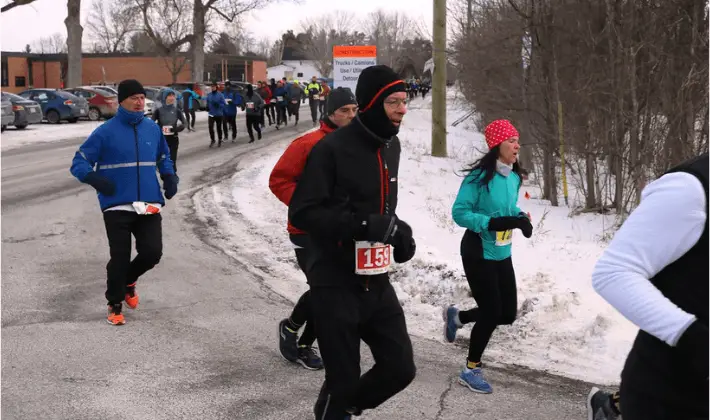Top 30 Most Commonly Used Running Abbreviations You Need To Know

Like many professions or pursuits, even running/ runners have a ‘lingo’ of their own that is often confusing and bordering-on-incomprehensible, especially to non-runners and sometimes even novice runners. Below is a shortlist of the most commonly used acronyms/abbreviations that runners use.
Commonly Used Running Abbreviations and Acronyms
AT: Anaerobic Threshold. Also LT (Lactate Threshold): It is the point where the body switches from aerobic (with oxygen) to anaerobic (without oxygen) metabolism i.e. breathing does not provide enough oxygen to meet the energy needs of the body.
BQ/ BQ Time: Boston Qualifier Time. Running a “BQ” means that a runner met the age/gender qualifying time standard to apply for entry to the Boston Marathon.
BPM: Beats Per Minute. It is the heart-rate or the number of heartbeats per minute.
CR: Course Record. Fastest time run on a certified running course.
DFL: Dead Freaking Last. As the name suggests, it is the last person to cross the finish line
DNS: Did Not Start. Someone who registered for the race but did not start.
DNF: Did Not Finish. Listed in race results when a runner/racer started the race but did not finish
DOMS: Delayed Onset Muscle Soreness. Type of muscle soreness that usually occurs 24 to 48 hours after a race/ long run/ intense effort.
FKT: Fastest Known Time. It is the speed record for a running or hiking route that is usually on trails. Mostly self-organized and in small groups/solo attempts
FM: Full Marathon. Usually referred to as “Marathon” – a distance of 42.2km or 26.2miles
HM: Half Marathon. A distance of 13.1 miles (21.0975 kilometers) – half the distance of a marathon.
HR/HR Zone: Heart Rate is the number of times the heart beats per minute. A lot of trainers use ‘Target HR zone’ to design intensity level of the workout based on the maximum heart rate of the runner.
HRM: Heart Rate monitor. A device you wear to measure, monitor and display the heart rate continuously. Usually available as a chest strap with electrode sensors which detect and transmit data to a receiver such as a watch or phone app.
ITBS: Iliotibial Band Syndrome. It refers to an injury to the IT band on the outer leg which runs from the hip, down the thigh, across the knee and through the shin.
LSD: Long Slow Distance. Refers to a Long Run covering up to 30% of the total weekly mileage and performed at a slow, comfortable pace to build up stamina.
MHR: Maximum Heart Rate. Refers to the total number of heart beats per minute during strenuous exercise. Used as a benchmark for determining the relative health of an individual.
MUT: Mountain/ Ultra/ Trail runner. A MUT is a runner who runs on mountains, on trails or runs ultra distances
MP: Marathon Pace. The pace at which a runner plans’ to run the marathon (or actually runs the marathon). Usually used in few training runs leading to a marathon
MPW: Mileage Per Week/ Miles Per Week. As the name suggests, it the total mileage you are planning to run / actually run in any given week
NR: National Record. Fastest time in the country run at any given distance.
PR: Personal Record. The ‘speediest’ or ‘best time’ of a runner for any given distance.
PB: Personal Best. Used interchangeably with PR
PW: Refers to a runner’s worst time at a specific distance.
RHR: Resting Heart Rate. It is the number of times your heart beats per minute while at complete rest. It is sometimes used as an indicator of good health. Resting heart rate decreases as your heart becomes stronger through aerobic exercise
RICE: Rest, Ice, Compress, Elevate. Regimen sometimes recommended by doctors to treat sports injuries. Rest (Immediately rest the affected area), Ice (To help reduce the pain and swelling during the first 48hrs of injury), Compression (Use medical bandage to wrap injured area) and Elevate (Raise the injured body part as much as possible)
TM: Treadmill
VO2MAX: Maximum (Max) Rate (V) of Oxygen (O2). The maximum oxygen uptake (VO2 max) tells how efficiently the body can use oxygen during exercise.
WR: World Record. Fastest time in the world run for any given distance.
XC: Cross Country. When teams/ individuals run a race on open-air courses over natural terrain – surface may include grass or dirt and course might pass through flat ground, hills, woodlands and open country
XT: Cross training. All other workouts that a runner might include in their training program to improve overall fitness, prevent injury and as an active recovery alternate to running. Include Strength training, cycling, swimming, yoga, etc
And while we are on abbreviations/ acronyms, let us also take a quick look at the most common running distances/ races.
List of Distances
Usually races in listed in ‘meters’ are held/run on standard tracks while races listed in miles/kilometres, are road/ trail races
100 meters: Shortest common sprint race held outdoors.
200 meters: 1/2 lap around a standard track.
400 meters: Approximate 1/4 mile, one lap around a standard track.
800 meters: Approximate 1/2 mile, two laps around a standard track.
1200 meters: Approximate 3/4 mile, three laps around a standard track.
1500 meters: 0.93 miles, Metric mile, 3 3/4 laps around the track.
5k: 5km/ 3.1 miles
10k: 10km/ 6.2 miles
15k: 15km/ 9.3 miles
Half Marathon: 21.1km/ 13.1 miles
Marathon/Full Marathon: 42.2km/ 26.2 miles.
Ultra marathon: Any race with a distance greater than 26.2 miles is considered an ultramarathon but usually refers to races which are 50k or above.
50k: 50km/ 31.1 miles
Tri/triathlon: A race that involves an athlete to swim, cycle and run a certain distance under each of the three sports.
½ Ironman: Involves 1.2 miles of swimming, 56 miles of cycling and 13.1 miles of running.
Ironman: Involves 2.4 miles of swimming, 112 miles of cycling and 26.2 miles of running.
If you need more help on Running/ Runners’ Terminology, head over to read “The ABC of Running”.





